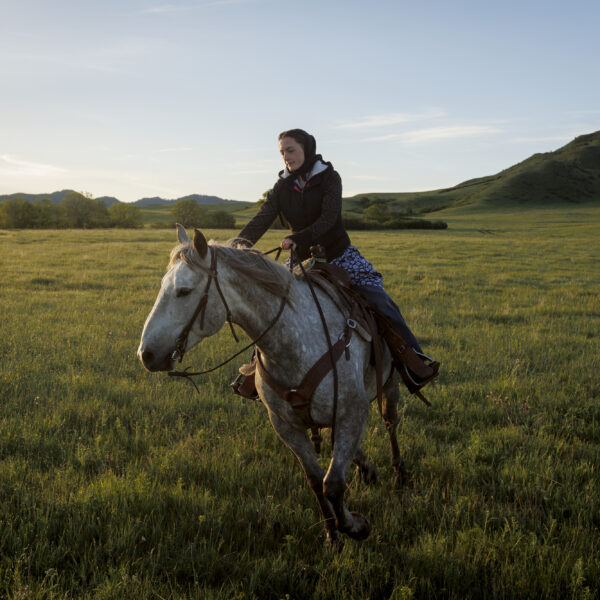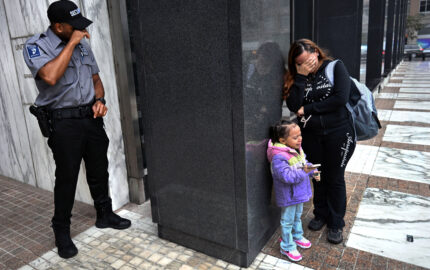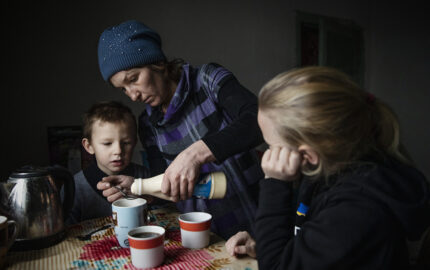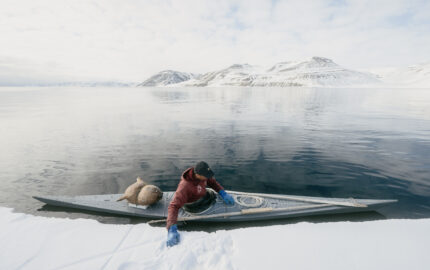Since 2009, I’ve been photographing the Hutterite communities that dot the Canadian prairie provinces and northwestern United States, primarily in my home province of Manitoba, but also in Saskatchewan and Montana. The Hutterites, Anabaptists whose roots grew out of the Radical Reformation of the 16th century, practice community of goods, in which all property and material goods are shared amongst the entire colony. They are considered one of the most successful models of communal living in modern history. Once nearly extinct, there are between 40,000 and 50,000 Hutterites living in Canada and the U.S., according to various census reports.
I began this long-term project thinking I’d spend a year on it, maybe two, though it was hard to even imagine committing to a story for more than a year. But time has added a valuable layer to the project, providing depth by showing the subtle changes over the long term: children growing up, friends I’ve made starting families of their own, people leaving and returning, technology and style changes. There are many photos I’ve made that have literally taken years of connections and relationship building. In 2023, I was invited to photograph the wake and funeral of Susannah Wollman, the oldest living Hutterite at the time at just over 100. I had met and photographed her the previous fall, and I knew her community. My 14 years of previous work allowed me into Susannah’s funeral.
Having built relationships and friendships at several Hutterite communities, I often am given ideas to explore or interesting events or people to photograph. Through a friend from Deerboine Colony, I first heard about cattle branding at Forty Mile Colony in Montana. These were “real cowboys” at Forty Mile, I was told. Farming is the primary economic driver among Manitoba Hutterite colonies, but ranching of the type seen in Alberta and Montana isn’t really a thing here. Farms have cattle, but not large ranches. I had long wanted to visit Forty Mile to experience their ranching culture, and I was able to do so in the spring of 2023.
Forty Mile Hutterite Colony takes its name from a former stagecoach stop roughly halfway between Hardin, Montana, and Sheridan, Wyoming. The colony is isolated within the foothills north of the Bighorn Mountains and the next closest colony, Mountain View, is roughly two hours away.
The community is small, at just over 30 members — a few families. They make most of their income from ranching. Their herd of around 1,800 cattle are grazed throughout the foothills and mountains. Every spring, after calving, the new calves are rounded up to be vaccinated, castrated, and branded. The brand keeps cattle from different ranches from getting mixed up and prevents theft. The work requires more people than the colony has, so men and women from other colonies come to help. This year included Hutterites from colonies in Montana, Washington, and Saskatchewan.
The day starts at 4 a.m. with the rounding up and saddling of horses. The women do all the same work as the men, including riding, roping, and wrestling calves; they also do the cooking and cleaning. We were out in the foothills shortly after sunrise and work would go all day until late afternoon, often followed by socializing and volleyball games late into the evening. Branding is hard work but offers a chance to visit with friends and neighbors who have come to help out.
Cattle are rounded up by riders on horseback and driven to pens, where the calves are separated from the adults. Then the calves are branded, vaccinated, castrated, and let free to return to their mothers. The work is messy and chaotic and can be dangerous, but the men, women, and their horses work in incredible synchronicity as they wield razor-sharp scalpels and red-hot brands amid fast-moving cattle and horses.
I photographed and filmed every bit of branding over three days. Daybreak was beautiful and calm with cool temperatures and dew in the hills. I made this frame of Victoria atop a horse named Murphy, from Forty Mile, early in my first day. I didn’t know what to expect — I was just beginning to get to know people and was frantically making photos in all directions as everyone mounted up before heading out for roundup.
I try to find a balance — not spooking anyone too much with my camera too early on, while also not wanting to miss anything. I also am sensitive to how unnerving having a camera pointed at you can be. For me, this photo feels like the calm before the storm. It is quiet and stands in contrast to the organized mayhem that follows for most of the day. For the most part, as the day progressed and everyone got into the rhythm of work, it became easier for me to work as well, and everyone became less conscious of the obtrusive photographer.
Not that everything went smoothly. As the roundup was still well underway, I was becoming a bit too comfortable and started getting closer to the action than I should have. As the cattle were being corralled into the pens, a group of them spooked and decided to make a break for it. I became an added stress for the riders to worry about while they had to work quickly to round them up. I received a well-deserved admonishment from one of the head riders, for which I apologized repeatedly. Our work requires a tricky balance of getting close enough to tell the story intimately without inadvertently affecting the story or becoming part of it. Sometimes we get this balance wrong. Thankfully I was still welcomed to keep documenting the branding. The days only got better.
I don’t consider myself the most talented photojournalist — I make lots of mistakes and work I’m unhappy with. But I am stubborn, and I keep going back. I invest a lot of time, and that time ends up leading to moments that I feel lucky and grateful to be a part of. I believe in the classic advice, “Put yourself in the right position for moments to happen.” For me, that’s the be-all of project work: showing up, both physically and emotionally. Often, you put in the work and show up and you aren’t necessarily rewarded with the moment and the light and the story all coming together. But I think the feeling of those moments where everything does work out and come together, are the addictive hook of both journalism and photography. I keep chasing those moments, anyway.
I love journalism because it forces me into engagement with people and communities of wildly different backgrounds, beliefs, and experiences. We increasingly isolate ourselves and become siloed into groups that just reinforce our own beliefs and experience. I love that I have friends through this project that have vastly different beliefs from mine, but that we can respect each other and laugh together and disagree and learn from each other. Visiting Forty Mile Colony was an incredible experience. I hope to go back.



